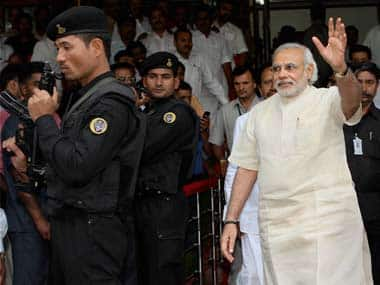Once upon a time there was a Narendra Modi, an enthusiastic prisoner of the image of the posterboy of Hindutva. In 2003, when he campaigned for the BJP in Rajasthan before the Assembly election, his every gesture, every word, every snarl was aimed at airbrushing that image. [caption id=“attachment_1196069” align=“alignleft” width=“380”]  BJP’s PM candidate Narendra Modi. PTI[/caption] He was extremely fond of figures, but of a different variety. For instance, while addressing a rally in the Walled City of Jaipur late one November 2003 night, his favourite measurement was that of his own chest. “36 inch ka seena,” he would repeatedly say in some context or the other, but mainly to express his pride. Index of masculinity and not that of development was his catchphrase. Shahzada might be his favourite word today. Back then, it was Suleiman. “Arre, Suleiman,” he would say every time he wanted to address the chief minister of Rajasthan. His arrival was always eagerly awaited. But much less than his departure, which would finally allow the edgy administration to drop its guard and the people in the Walled City to exhale and release the asphyxiating tension in the air. That Modi was nowhere to be seen at a huge gathering of tribals organized by the BJP in Udaipur on Saturday. The large gathering, mostly from Mewar’s tribal belt, instead saw a dramatically different Modi, whose every word, gesture and snarl was aimed at erasing the persona of 2003. Shahzada, of course, was the main theme. But the memory of Rahul Gandhi’s speeches was invoked only to be dismissed as confusing mumbo-jumbo. The erstwhile mascot of Hindutva seemed more than keen to become the voice of the votebank Congress claims to be its own. For a change, he called chief minister Ashok Gehlot by name. And then he dismantled Gehlot’s image, saying that the Rajasthan government is incapable of protecting minorities. He referred to the history of communal clashes in Gopalgarh, where minorities were killed two years ago in violent clashes; he claimed even the minority commission had lost faith in the Rajasthan government. He said even the Shahzada didn’t trust Gehlot’s government, Modi, arguing that the lack of trust was betrayed when the Congress VP made an unannounced, secret visit to Gopalgarh. Modi, it is clear, is no longer shy of starting the ‘Is Congress really the protector of minorities?’ debate. While Modi’s transformation is understandable, the complete metamorphosis of his audience is one of the defining stories of the election campaign in Rajasthan. For his listeners earlier, Modi was mainly a symbol of their anguish against the appeasement of minorities and the resultant emotional backlash. But today, he means different things to different people. His black and white image has acquired different shades. The angst against the politics of secularism, though as a mellowed-down version, still remains the backdrop. But for his supporters he has also become the man who would get them jobs, protect their honour, stand up to Pakistan, compete with the US, weed out corruption, bring out unimaginable development and, in the process, decimate the Congress and its dynastic culture. The litany of expectations from Modi is scary. Modi, it has become clear, is riding a tiger that can one day devour him. The atmosphere in the cities he visits is also in stark contrast to 2003. Earlier, except for the frenzied activity at the venue, there would be an uneasy calm all around. His rallies back then were like a private and personal soliloquy for the devoted and the faithful. But in Udaipur on Saturday it was clear that Modi shows have now become public spectacles. From the gathering of a few, cautious believers, many of whom looked apologetic for being there, the spectacle in Udaipur was an unabashed carnival of the hopeful. For the BJP this could be a heartening sign; for the Congress a signal for introspection. Modi’s persona has acquired so many connotations that running it down with memoirs of the dynasty and the secularism agenda would now be next to impossible. For his fans, it seems now, Modi can fall only if he fails to live up to their expectations. His rivals can now only hope that the bubble of expectations bursts as fast as possible. They can only pray that just like his 2003 image, his current persona also becomes another story’s opening line: Once upon a time there was a Modi.
While Modi’s transformation is understandable, the complete metamorphosis of his audience is one of the defining stories of the election campaign in Rajasthan.
Advertisement
End of Article


)
)
)
)
)
)
)
)
)



